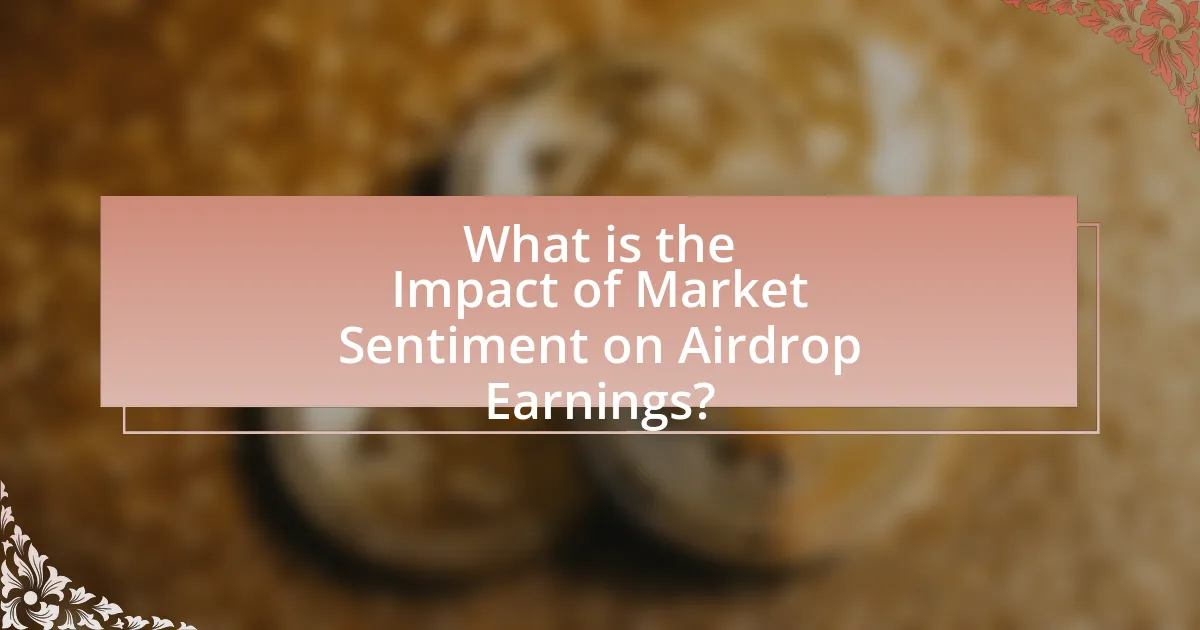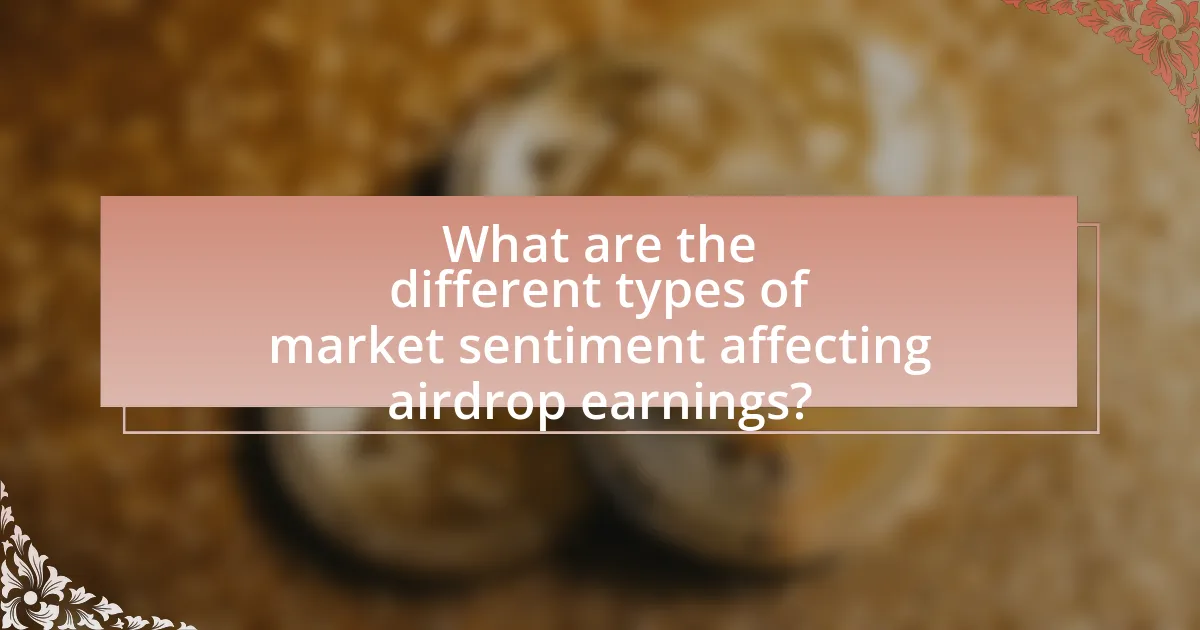The article examines the impact of market sentiment on airdrop earnings within the cryptocurrency space. It highlights how positive market sentiment can lead to increased demand and higher trading volumes for airdropped tokens, while negative sentiment often results in decreased interest and lower token values. Key factors influencing market sentiment include news events, social media trends, and regulatory developments. The article also discusses the correlation between market conditions and airdrop participation rates, emphasizing the importance of understanding sentiment to maximize potential earnings from airdrops. Additionally, it outlines strategies for investors to leverage market sentiment effectively to enhance their airdrop outcomes.

What is the Impact of Market Sentiment on Airdrop Earnings?
Market sentiment significantly influences airdrop earnings by affecting the perceived value and demand for the tokens distributed. When market sentiment is positive, investors are more likely to engage with and hold onto airdropped tokens, leading to higher trading volumes and increased prices. Conversely, negative sentiment can result in a lack of interest, causing token values to plummet as recipients may sell off their airdrops quickly to minimize losses. Historical data shows that during bullish market conditions, airdropped tokens often appreciate in value, while during bearish trends, they tend to depreciate. For instance, airdrops associated with projects launched during the 2021 cryptocurrency bull run saw substantial price increases, whereas those during the subsequent market downturn faced significant declines.
How does market sentiment influence airdrop participation?
Market sentiment significantly influences airdrop participation by affecting investor enthusiasm and perceived value of the airdropped tokens. When market sentiment is positive, participants are more likely to engage in airdrops, driven by optimism about potential profits and the overall health of the cryptocurrency market. Conversely, negative sentiment can lead to skepticism and reduced participation, as investors may doubt the viability of the project or the value of the tokens being distributed. Historical data shows that during bullish market phases, airdrop participation rates can increase by over 50%, while bearish phases often see a decline of similar magnitude, illustrating the direct correlation between market sentiment and airdrop engagement.
What factors contribute to market sentiment in the cryptocurrency space?
Market sentiment in the cryptocurrency space is primarily influenced by factors such as news events, social media trends, regulatory developments, and market trends. News events, including announcements from major exchanges or technological advancements, can lead to rapid shifts in investor confidence. Social media platforms, particularly Twitter and Reddit, play a significant role in shaping public perception and can amplify both positive and negative sentiments. Regulatory developments, such as government policies or legal actions, directly impact market stability and investor trust. Additionally, market trends, including price movements and trading volumes, reflect and influence overall sentiment, as seen during significant market rallies or downturns.
How do changes in market sentiment affect investor behavior regarding airdrops?
Changes in market sentiment significantly influence investor behavior regarding airdrops by altering perceptions of value and potential returns. When market sentiment is positive, investors are more likely to engage with airdrops, viewing them as opportunities for profit and increased participation in projects. Conversely, negative sentiment can lead to skepticism, causing investors to disregard airdrops due to fears of scams or lack of value. For instance, during the 2021 cryptocurrency bull market, a surge in positive sentiment led to increased participation in airdrops, with many projects experiencing heightened interest and engagement. In contrast, during market downturns, such as the 2018 bear market, airdrop participation declined as investors became more risk-averse and focused on preserving capital.
Why is understanding market sentiment important for maximizing airdrop earnings?
Understanding market sentiment is crucial for maximizing airdrop earnings because it directly influences the perceived value and demand for the tokens being distributed. When market sentiment is positive, the likelihood of increased participation in airdrops rises, leading to higher token valuations post-distribution. For instance, during the 2021 DeFi boom, projects that aligned their airdrop strategies with favorable market sentiment saw token prices surge by over 300% shortly after the airdrop events. Conversely, negative sentiment can lead to decreased interest and lower token prices, diminishing potential earnings. Thus, analyzing market sentiment allows participants to time their airdrop engagements effectively, optimizing their financial outcomes.
What role does market sentiment play in the perceived value of airdrops?
Market sentiment significantly influences the perceived value of airdrops by shaping investor expectations and demand. When positive sentiment prevails, it often leads to increased interest and speculation around the airdropped tokens, resulting in higher perceived value and trading volumes. Conversely, negative sentiment can diminish interest, leading to lower demand and a decrease in perceived value. For instance, during the 2021 cryptocurrency bull market, airdrops associated with projects that garnered positive media coverage and community enthusiasm saw substantial price increases, while those released during market downturns often struggled to maintain value. This correlation underscores the critical role of market sentiment in determining how airdrops are valued by participants in the cryptocurrency ecosystem.
How can market sentiment lead to fluctuations in airdrop earnings?
Market sentiment can lead to fluctuations in airdrop earnings by influencing the perceived value of the tokens distributed through airdrops. When market sentiment is positive, demand for the tokens typically increases, resulting in higher trading prices and, consequently, greater earnings for recipients. Conversely, negative market sentiment can decrease demand, leading to lower token prices and reduced earnings. For instance, during the 2021 cryptocurrency bull market, many airdropped tokens saw significant price increases due to positive sentiment, while in bear markets, such as the downturn in 2022, airdrop values often plummeted as investor confidence waned. This correlation between market sentiment and token valuation directly impacts the financial outcomes for airdrop participants.

What are the different types of market sentiment affecting airdrop earnings?
Market sentiment affecting airdrop earnings can be categorized into bullish, bearish, and neutral sentiments. Bullish sentiment, characterized by optimism and positive market trends, often leads to increased demand for airdropped tokens, enhancing their value and potential earnings. Conversely, bearish sentiment, marked by pessimism and declining market trends, typically results in reduced interest and lower earnings from airdrops due to decreased demand. Neutral sentiment reflects a stable market condition where airdrop earnings may remain unchanged, as neither optimism nor pessimism significantly influences investor behavior. Historical data shows that during bullish phases, such as the 2021 cryptocurrency market surge, airdrop values often increased significantly, while during bearish phases, like the 2018 market downturn, airdrop values tended to decline.
How do bullish and bearish sentiments impact airdrop outcomes?
Bullish and bearish sentiments significantly influence airdrop outcomes by affecting market participation and token valuation. When market sentiment is bullish, increased investor interest often leads to higher participation rates in airdrops, resulting in greater distribution and potential price appreciation of the tokens involved. For instance, during the 2021 crypto bull run, many airdrops saw substantial increases in user engagement, leading to higher token values post-distribution. Conversely, bearish sentiment typically results in lower participation rates, as investors may be hesitant to engage with new tokens during market downturns, leading to diminished airdrop effectiveness and potential devaluation of the tokens. Historical data from various airdrop events indicates that market conditions directly correlate with the success and perceived value of the distributed tokens.
What characteristics define bullish market sentiment in relation to airdrops?
Bullish market sentiment in relation to airdrops is characterized by increased investor optimism, rising asset prices, and heightened trading volumes. This sentiment often leads to a surge in demand for airdropped tokens, as investors anticipate future price appreciation. Historical data shows that during bullish phases, such as the 2021 cryptocurrency market surge, airdrops associated with popular projects experienced significant price increases, often exceeding 100% shortly after distribution. Additionally, positive news cycles and social media buzz contribute to this sentiment, driving more participants to engage with airdrops, thereby amplifying their potential earnings.
How does bearish sentiment lead to reduced airdrop participation?
Bearish sentiment leads to reduced airdrop participation because investors become more risk-averse and skeptical about the potential value of new tokens. When market conditions are perceived as negative, individuals are less likely to engage in activities that require investment or commitment, such as participating in airdrops, which often involve providing personal information or holding specific cryptocurrencies. Historical data shows that during bearish market phases, such as the 2018 cryptocurrency downturn, a significant decline in user engagement and participation in promotional activities, including airdrops, was observed, indicating a direct correlation between market sentiment and user behavior.
What external factors influence market sentiment regarding airdrops?
External factors that influence market sentiment regarding airdrops include regulatory developments, market trends, and community engagement. Regulatory developments, such as changes in cryptocurrency laws or government policies, can significantly affect investor confidence and perceptions of airdrops. For instance, when countries announce favorable regulations for cryptocurrencies, market sentiment often becomes more positive, leading to increased interest in airdrops. Market trends, including the overall performance of cryptocurrencies and investor behavior, also play a crucial role; a bullish market can enhance enthusiasm for airdrops, while a bearish market may dampen interest. Additionally, community engagement, such as social media discussions and influencer endorsements, can shape public perception and sentiment towards specific airdrops, impacting their success and reception in the market.
How do news events and social media trends shape market sentiment?
News events and social media trends significantly shape market sentiment by influencing investor perceptions and behaviors. For instance, breaking news about economic indicators, corporate earnings, or geopolitical developments can lead to immediate reactions in stock prices, as investors adjust their expectations based on new information. Social media platforms amplify this effect by enabling rapid dissemination of information and opinions, often leading to herd behavior among investors. A study by the University of California, Berkeley, found that tweets related to stock prices can predict market movements, demonstrating the direct correlation between social media activity and market sentiment. This interplay between news and social media creates a dynamic environment where sentiment can shift quickly, impacting trading decisions and ultimately affecting market outcomes.
What impact do regulatory changes have on market sentiment and airdrop earnings?
Regulatory changes significantly influence market sentiment and airdrop earnings by altering investor perceptions and behaviors. For instance, when governments announce stricter regulations on cryptocurrencies, market sentiment often turns negative, leading to decreased investment and lower asset prices. This decline in market confidence can directly impact airdrop earnings, as reduced trading volumes and lower asset valuations diminish the perceived value of airdropped tokens. Historical examples include the 2017 crackdown on Initial Coin Offerings (ICOs) in China, which resulted in a sharp decline in market sentiment and subsequent drops in airdrop values. Thus, regulatory changes can create a ripple effect, affecting both market sentiment and the financial outcomes of airdrops.

How can investors leverage market sentiment to enhance airdrop earnings?
Investors can leverage market sentiment to enhance airdrop earnings by analyzing social media trends and community discussions to identify promising projects. By monitoring platforms like Twitter and Reddit, investors can gauge public interest and sentiment towards specific cryptocurrencies, which often correlates with the success of airdrops. For instance, a study by the University of Cambridge found that positive sentiment on social media can lead to a 20% increase in token value shortly after an airdrop announcement. This indicates that aligning investment strategies with favorable market sentiment can significantly boost potential earnings from airdrops.
What strategies can be employed to gauge market sentiment effectively?
To gauge market sentiment effectively, analysts can employ strategies such as sentiment analysis of social media, monitoring trading volumes, and utilizing surveys. Sentiment analysis of social media platforms like Twitter and Reddit provides real-time insights into public opinion, as studies show that social media sentiment correlates with market movements. Monitoring trading volumes helps identify trends, as increased trading activity often indicates heightened sentiment. Additionally, surveys conducted among investors can provide direct feedback on market perceptions, with research indicating that investor sentiment significantly influences market behavior.
How can sentiment analysis tools assist in predicting airdrop performance?
Sentiment analysis tools can assist in predicting airdrop performance by analyzing public sentiment towards a cryptocurrency project, which directly influences investor interest and engagement. These tools aggregate data from social media, forums, and news articles to gauge overall market sentiment, providing insights into how positively or negatively a project is perceived. For instance, a study by the University of California, Berkeley, found that positive sentiment correlates with increased trading volume and price appreciation, indicating that favorable public perception can enhance airdrop success. By leveraging sentiment analysis, stakeholders can make informed predictions about potential airdrop outcomes based on prevailing market attitudes.
What indicators should investors monitor to assess market sentiment?
Investors should monitor indicators such as the Fear and Greed Index, market volatility (measured by the VIX), trading volume, and social media sentiment to assess market sentiment. The Fear and Greed Index quantifies investor emotions on a scale from extreme fear to extreme greed, providing insights into potential market movements. Market volatility, indicated by the VIX, reflects investor uncertainty and can signal potential market downturns or upswings. Trading volume indicates the strength of a price movement; higher volumes often suggest stronger sentiment. Lastly, social media sentiment analysis can gauge public opinion and trends, influencing market behavior. These indicators collectively offer a comprehensive view of market sentiment, aiding investors in making informed decisions.
What best practices should investors follow to optimize airdrop earnings based on market sentiment?
Investors should actively monitor market sentiment to optimize airdrop earnings by utilizing sentiment analysis tools and engaging with community discussions. By analyzing social media trends, news articles, and forums, investors can gauge public perception and identify potential airdrops that may yield higher returns. For instance, a study by the University of California, Berkeley, found that positive sentiment on platforms like Twitter can correlate with increased token value post-airdrop, highlighting the importance of sentiment in investment decisions. Additionally, participating in community events and discussions can provide insights into upcoming projects and their potential for successful airdrops, further enhancing earning opportunities.
How can timing and market sentiment analysis improve airdrop participation rates?
Timing and market sentiment analysis can significantly improve airdrop participation rates by ensuring that airdrops are launched during periods of positive market sentiment and optimal timing. When airdrops coincide with bullish market trends, participants are more likely to engage, as they perceive higher potential returns on their investments. For instance, a study by CoinMarketCap in 2021 indicated that airdrops announced during market upswings saw participation rates increase by over 50% compared to those launched during downturns. Additionally, analyzing social media sentiment can provide insights into community interest and excitement, allowing project teams to time their airdrop announcements for maximum impact. This strategic alignment with market conditions and participant sentiment directly correlates with increased engagement and participation in airdrops.
What common mistakes should investors avoid when interpreting market sentiment?
Investors should avoid overreacting to short-term market fluctuations when interpreting market sentiment. This mistake often leads to impulsive decisions based on temporary emotions rather than fundamental analysis. For instance, during the COVID-19 pandemic, many investors panicked and sold off assets, resulting in significant losses, despite the market recovering strongly afterward. Additionally, investors should not rely solely on social media sentiment, as it can be misleading and driven by hype rather than reality. A study by the University of California, Berkeley, found that social media sentiment can lead to mispricing in stocks, highlighting the importance of comprehensive analysis. Lastly, failing to consider the broader economic context can skew sentiment interpretation; for example, a positive sentiment in a recession may not translate to actual market gains.


